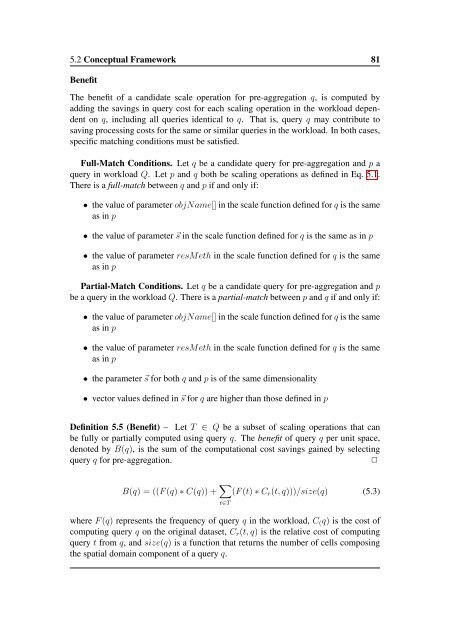Applying OLAP Pre-Aggregation Techniques to ... - Jacobs University
Applying OLAP Pre-Aggregation Techniques to ... - Jacobs University
Applying OLAP Pre-Aggregation Techniques to ... - Jacobs University
You also want an ePaper? Increase the reach of your titles
YUMPU automatically turns print PDFs into web optimized ePapers that Google loves.
5.2 Conceptual Framework 81<br />
Benefit<br />
The benefit of a candidate scale operation for pre-aggregation q, is computed by<br />
adding the savings in query cost for each scaling operation in the workload dependent<br />
on q, including all queries identical <strong>to</strong> q. That is, query q may contribute <strong>to</strong><br />
saving processing costs for the same or similar queries in the workload. In both cases,<br />
specific matching conditions must be satisfied.<br />
Full-Match Conditions. Let q be a candidate query for pre-aggregation and p a<br />
query in workload Q. Let p and q both be scaling operations as defined in Eq. 5.1.<br />
There is a full-match between q and p if and only if:<br />
• the value of parameter objName[] in the scale function defined for q is the same<br />
as in p<br />
• the value of parameter ⃗s in the scale function defined for q is the same as in p<br />
• the value of parameter resMeth in the scale function defined for q is the same<br />
as in p<br />
Partial-Match Conditions. Let q be a candidate query for pre-aggregation and p<br />
be a query in the workload Q. There is a partial-match between p and q if and only if:<br />
• the value of parameter objName[] in the scale function defined for q is the same<br />
as in p<br />
• the value of parameter resMeth in the scale function defined for q is the same<br />
as in p<br />
• the parameter ⃗s for both q and p is of the same dimensionality<br />
• vec<strong>to</strong>r values defined in ⃗s for q are higher than those defined in p<br />
Definition 5.5 (Benefit) – Let T ∈ Q be a subset of scaling operations that can<br />
be fully or partially computed using query q. The benefit of query q per unit space,<br />
denoted by B(q), is the sum of the computational cost savings gained by selecting<br />
query q for pre-aggregation.<br />
✷<br />
B(q) = ((F (q) ∗ C(q)) + ∑ t∈T<br />
(F (t) ∗ C r (t, q)))/size(q) (5.3)<br />
where F (q) represents the frequency of query q in the workload, C ( q) is the cost of<br />
computing query q on the original dataset, C r (t, q) is the relative cost of computing<br />
query t from q, and size(q) is a function that returns the number of cells composing<br />
the spatial domain component of a query q.
















